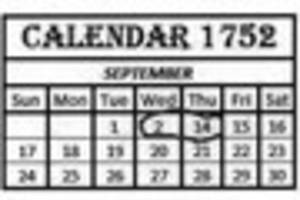 This is Tamworth --
This is Tamworth --MANY of us at this time of year are admiring our new calendars, often works of art, beauty and all nature can bestow – but can we trust them?
On the night of Wednesday, February 2, 1752, the majority of the good folk of Tamworth went to their beds for a peaceful night's sleep.
But when they awoke the following morning, it was February 14!
What had become of the missing 11 days?
For the most part, Tamworth's ordinary working folk of the 18th century never cared a fig what the day or date was, unless it was pay day, the Sabbath, other holy days, such as Good Friday, Easter or Christmas, or the Cherry Fair, which was unique to Tamworth and meant a rare day off for a good many workers.
The vast majority could neither read nor write and, most of the time, had no need to know what the date was.
The business of time and dates was left to the church, landowners, merchants, lawyers and the government.
But throughout the morning of February 14, the news spread like wild-fire around the town and people began asking questions.
Had they been robbed of 11 days of their lives? Was there some devilish scheme afoot?
Folk who normally paid no heed to dates suddenly became very concerned. What had happened?
For local churchmen, the educated classes and those in the know the answer was simple.
In 1751 the British Government passed a parliamentary bill known as 'The British Calendar Act', changing the date to bring us into line with Rome and most of Western Europe.
The same government act applied in all the British colonies, including America.
Until that date in 1752, Britain had been employing the Julian Calendar, introduced by Julius Caesar in the old Roman year of 709, (45BC).
Caesar introduced it after consulting an Alexandrian astronomer known as Sosigenes.
Unfortunately, the old Roman way of measuring the year was nowhere near accurate and had to be frequently amended.
His calendar served most of the civilised world quite well for over 1,500 years, except for the tiny discrepancy of 11½ minutes per year, a difference of 0.002%.
It had been based upon the calculation that from one summer solstice to the next was exactly 365 days and 6 hours.
The year was divided neatly into 12 months, with an extra day added to February every four years, much the same as today.
That tiny discrepancy of 11½ minutes may not have sounded much, but over 1,500 years it became noticeable.
The Spring Equinox was way off where it should have been, on March the 21, and Easter, the moveable feast, was allocated a date in accordance with the equinox and the phases of the moon.
If the calendar was out, then so was Easter.
Astronomers and the Roman Catholic Church were getting worried as the dates slipped further away from the seasons and something had to be done.
A new calendar, named the Gregorian Calendar, after Pope Gregory XIII, was conceived in 1582 and was more accurate in measuring the Solar year, on which most calendars are based. Christopher Clavius, astronomer, Jesuit priest and personal friend of Pope Gregory was the architect and although it was a great improvement on anything that went before, there was much hostility to its introduction.
Nevertheless it was established and the people of Rome were the first to accept it.
However, since the reign of Henry VIII England had broken with the Pope and Catholicism and a Protestant church had been established.
When Pope Gregory announced the introduction of the new calendar, it was Henry's daughter, Elizabeth I, who was on the throne and head of the Church of England.
In Tamworth she was revered as she had already granted the first of two charters to the town.
But under her reign the persecution of the Catholics was rife, with many people being accused of heresy and witchcraft.
In her eyes there were more important matters of state to deal with and there was no urgency to change a trivial thing such as a calendar, especially as the new one was a product of the much detested Catholic Church.
Pope Gregory XIII was a very influential and determined man and he encouraged Philip II of Spain to take the throne from Elizabeth.
As we all know, this resulted in Philip's failed attempt to invade England when his Armada was virtually destroyed.
The English victory left the 'Virgin Queen' glowing with satisfaction and she continued her policy of suppressing the Roman Catholics.
Mainly because of this, Britain dragged its feet for almost 200 years. But having a different calendar from most of her trading partners across Europe caused much confusion, often ending in poor business relations and loss of revenue.
Britain would have to embrace the change if she was to compete successfully in trading abroad.
Generally speaking, people do not like things they have known all their lives to change.
When the dates were changed one can only imagine the confusion caused, with land leases, anniversaries, births, marriages and deaths, not only for the good folk of Tamworth, but across the civilised world.
Once Christopher Clavius had worked out the mathematics and changed the date accordingly, he had to leave a system which would keep true to the seasons.
He stated that any centenary year that was not divisible by 400 would not be a leap year, therefore the years 1700, 1800 and 1900 were not leap years, whereas the years 1600 and 2000 were.
That keeps our time almost perfect, and the Gregorian calendar is now accepted as the universal calendar for civic purposes across the world. Reported by This is 17 hours ago.